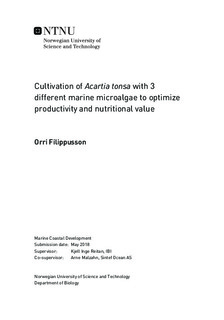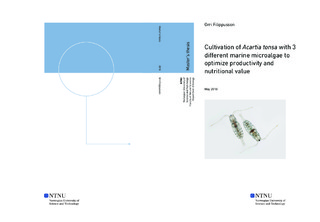| dc.description.abstract | The conventional method for first feeding of marine fish is to use enriched rotifers (Brachionus spp.) in the beginning and followed with enriched Artemia, before transfer to dry feed. Recent researches have shown that fish larvae fed on calanoid copepods have higher growth rate, survival rate, fewer deformities and stronger pigmentation than larvae fed on rotifers and Artemia. The reason for the difference is discussed to be due to better nutritional quality of the copepods, which met the larvae requirement, mainly the Highly Unsaturated Fatty Acids (HUFAs); DHA, EPA and ARA. However, it is generally considered to be difficult, labour intensive and expensive to have a large-scale production of copepods. It is therefore important to continue to develop and optimize the cultivation methods of copepods, making the production inexpensive and simple.
In this thesis, Acartia tonsa was cultivated with three different monoalgal diets with the microalgae species, Rhodomonas baltica, Tisochrysis lutea and Conticribra weissflogii, to optimize cultivation productivity and nutritional value of A. tonsa. Two separate studies were performed, first a nutritional study in a flow through system (FTS), and a second test study where A. tonsa was cultivated in a Recirculation Aquaculture System (RAS), integrated with a microalgae cultivation, a so-called copeponics system.
In conclusion, the study of the nutritional value of A. tonsa and microalgae species, showed that it was possible to manipulate the fatty acid composition of A. tonsa through the diet. The survival and growth rate of A. tonsa was highest when reared on R. baltica and T. lutea. The fatty acid composition of A. tonsa reared on R. baltica resulted in the most suitable HUFA ratio of DHA/EPA (~2) and EPA/ARA (~6) for marine fish larvae. The copeponics system functioned when using the microalgae R. baltica and the results gave strong indication that it was possible to reduce the water and nutrient consumption by ~90% and ~53%, respectively. However, the copeponics system should be further investigated for optimization.
Keywords: Acartia tonsa, Microalgae, Fatty acids, Cultivations methods, Copeponics | en |

